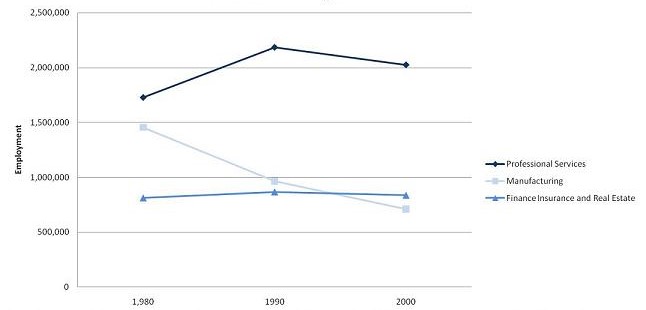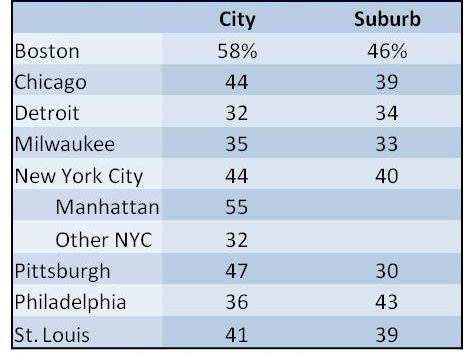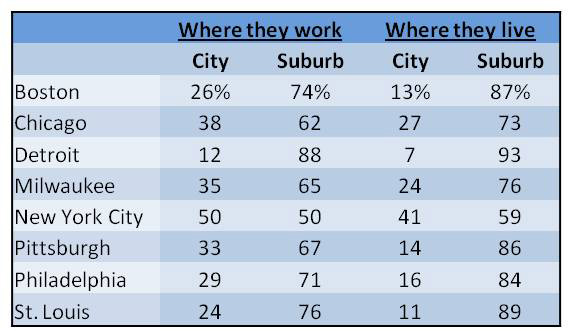A continued role for central cities?
The rapid flight of jobs and people from central cities, such as New York and Chicago, during the 1970s called into question what role, if any, they could play in metropolitan area economies. Today, many central cities of the Northeast and Midwest continue to be significant centers of commerce and employment in their metropolitan areas1. Over the past four to five decades, the manufacturing production sector has invariably shifted its activities from central cities to the suburbs (or moved away from metropolitan regions altogether). While doing so, this sector has shed many jobs. Yet certain important service sectors continue to find central cities to be desirable and hospitable locations in which to conduct their business. These include, for example, higher education, specialized medical services, and some types of government services that require face-to-face service delivery2. For such businesses, central cities remain accessible destinations for customers drawn from broad surrounding market areas. Customers are still willing to travel to service providers’ places of business located in cities.
In addition, a central city location can be highly productive for those businesses in which frequent face-to-face communication must take place among their workers or nearby business-to-business customers. The high density of central business districts can be very productive for such industries: Deals are struck, creative ideas are born, or temporary partnerships are formed as a result of frequent (and often unplanned) personal interactions that a central city facilitates. Such businesses often include law, financial services, advertising/marketing, public relations, management consulting, R&D, headquarters, and accounting (see figure below).
Chart 1. Jobs located in eight central cities

Source: Bureau of Census, as reported on HUD City Database.
Workers in these “city-centric” businesses are generally those who engage in creative, administrative, and highly skilled work activities3. In no small part, the rising share of high-skill jobs in the overall U.S. economy has helped to boost this economic role of central cities. As the rate of technological change has increased (and as global markets have become more open) over the past four decades, the wages and incomes of highly skilled and educated workers have grown considerably. More generally, a study by E. Glaeser and A. Saiz finds that, compared with other regions, “skilled cities” have been growing more rapidly for at least a century because they are more productive and also because they adapt more easily to economic shocks, such as changing industry fortunes.
Drawing on data from the U.S. Census Bureau’s American Community Survey (ACS), the table below presents the proportion of the city workforce with four-year college degrees (or higher) as compared with the rest of the metropolitan area (suburbs). The workers are reported here by their place of work although they may reside anywhere in the metropolitan area, be it city or suburb. Although educational attainment is far from a comprehensive measure of skill, it is a widely used measure since the level of educational attainment correlates strongly with wages and income. Generally, it is seen that the central city workers of the Northeast and Midwest tend to have greater educational attainment than their suburbs4; Detroit and Philadelphia are exceptions.5
Table 1. Of all workers, percent with a college degree (age 25+) in 2008

Although central cities tend to draw workers specializing in education-intensive occupations, the city’s share of such jobs in the metropolitan area, as compared with the surrounding suburbs, varies greatly. The first two columns of the table below show the shares of a metropolitan area’s college-educated workers employed in the city and in the suburbs. At one end of the spectrum, the city of Detroit accounts for only 12 percent of employed workers who have college degrees in the Detroit metropolitan area. At the other end of the spectrum, New York City hosts 50 percent of employed workers with a college degrees in the metropolitan region. In the industrial belt, central city Chicago leads with 38 percent; Milwaukee and Pittsburgh are not far behind. The central city of Detroit does lie far behind with 12 percent of the metropolitan area’s college educated workers.
Table 2. Job and home locations

The choice of residential location by those adults who are college-educated also has important consequences for central cities because such households generally contribute heavily in their payment of local taxes. Older cities of the Northeast and Midwest often have a disproportionate amount of low-income households for whom public services such as education must be financed through local taxes. Having more highly educated, high-income households living in the city boosts the local tax base, providing more revenue for local governments to provide these vital public services.
And as shown by various studies, where workers choose to live can affect where they choose to work—and vice versa. Accordingly, by attracting more highly educated (and other high-income) households, a city can draw in employers that are searching for available high-skill workers. Recognizing these incentives, many central city mayors have fashioned public amenities and services, such as parks, public art, and high-quality schools, to attract highly educated, high-income households in recent years.
The final two columns of the table above show the shares of college-educated households in each metropolitan area residing in the central city and in the nearby suburbs. Although gentrified neighborhoods can be found in virtually all cities, some central cities—for example, Detroit and St. Louis—can be seen as having fared poorly overall at attracting residents with high educational attainment. In addition, there are cities that have performed well at attracting jobs requiring a high level of education, but have done less well at drawing highly educated, high-income households such as Boston, Pittsburgh, and Philadelphia. Chicago and Milwaukee are seen to be fairly balanced and successful in attracting both college-educated workers and households.
Central cities in the Northeast and Midwest continue to struggle to find new and sustainable economic roles within metropolitan areas. Almost without exception, the city’s economic base has historically centered on manufacturing production and goods transportation—industries that have since diminished or re-located to the suburbs or elsewhere. Meanwhile, the nation’s economy has been restructuring to favor occupations requiring highly skilled and educated individuals. Fortunately for some central cities, their high population density, among other amenities, provides favorable conditions for these types of jobs. Some cities of the Northeast and Midwest have been successful at not only attracting highly skilled jobs, but also at attracting highly educated, high-income households. In addition to boosting the local tax base, such success may be highly desirable because employers tend to follow the available local work force.
Table 3. Percent working in central city by educational attainment, 2008

Footnotes
1 This is not to say that employment is centralizing. A recent study of 98 metropolitan areas by Elizabeth Kneebone observes that employment decentralized in almost every major industry between 1998 and 2006. E. Glaeser and M. Kahn find that, on average, less than 16 percent of metropolitan area employment locates within three miles of a city center.
2 Tim Bartik and George Erickcek characterized the economic roles of these industries for central cities’ economies, see reference.
3 One exception has been the centralization of entertainment and recreational activities in some central cities. Such activities—involving tourism, hotels, eating and drinking places, music and theatre venues, and sporting events– may not employ highly skilled or educated workers to the same degree.
4 The ACS enumerates city-based workers by their place of work; it also separately estimates workers by place of their residence.
5 Note that a city’s downtown or “central business district” often differs markedly in its share of college-educated workers, compared with the remainder of the city—this is illustrated by Manhattan versus the rest of New York City in table 1 . In addition, a study by E.L. Birch of 44 selected cities from 1970 to 2000 finds that young and educated households are trending toward living downtown, but that downtowns are also often the domiciles of some of the most and least affluent population groups.








